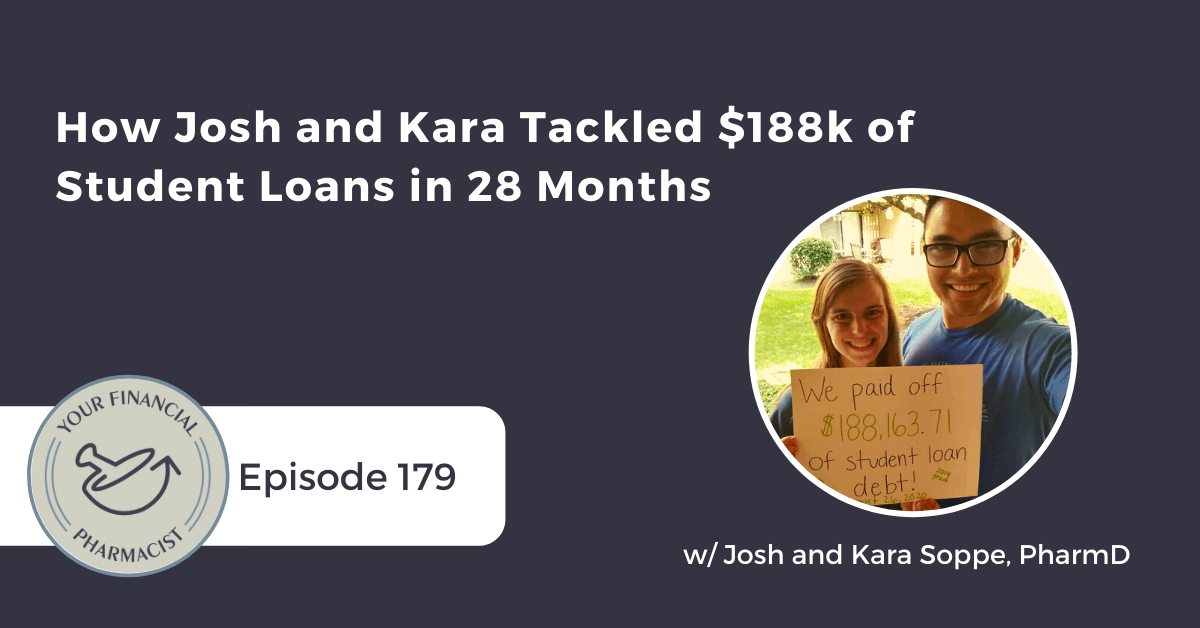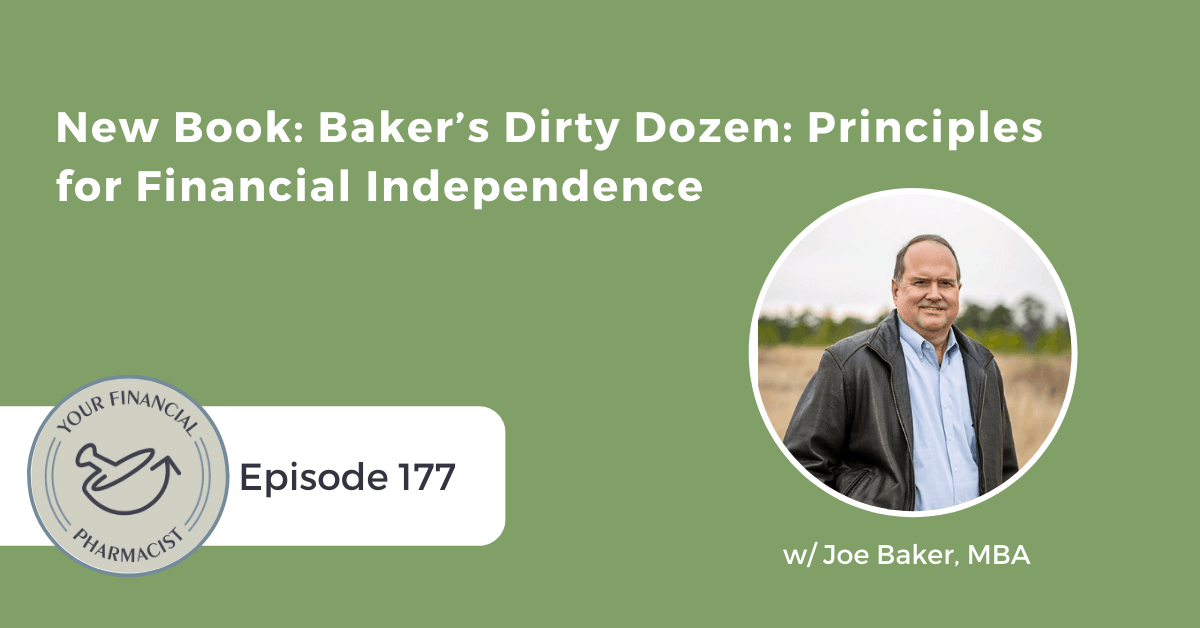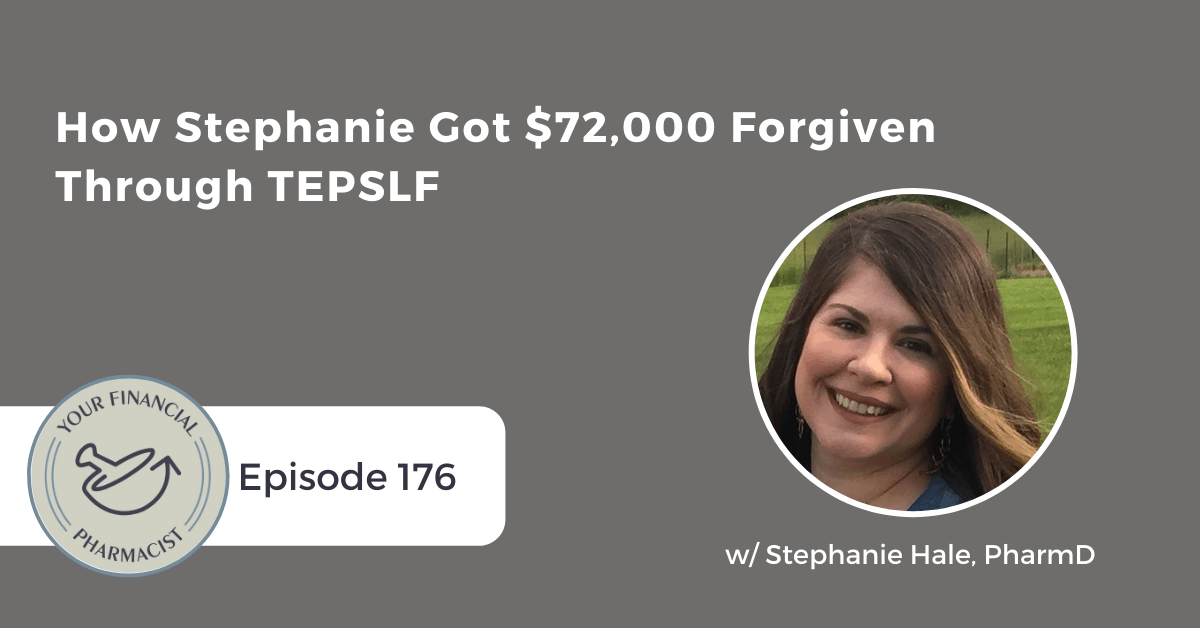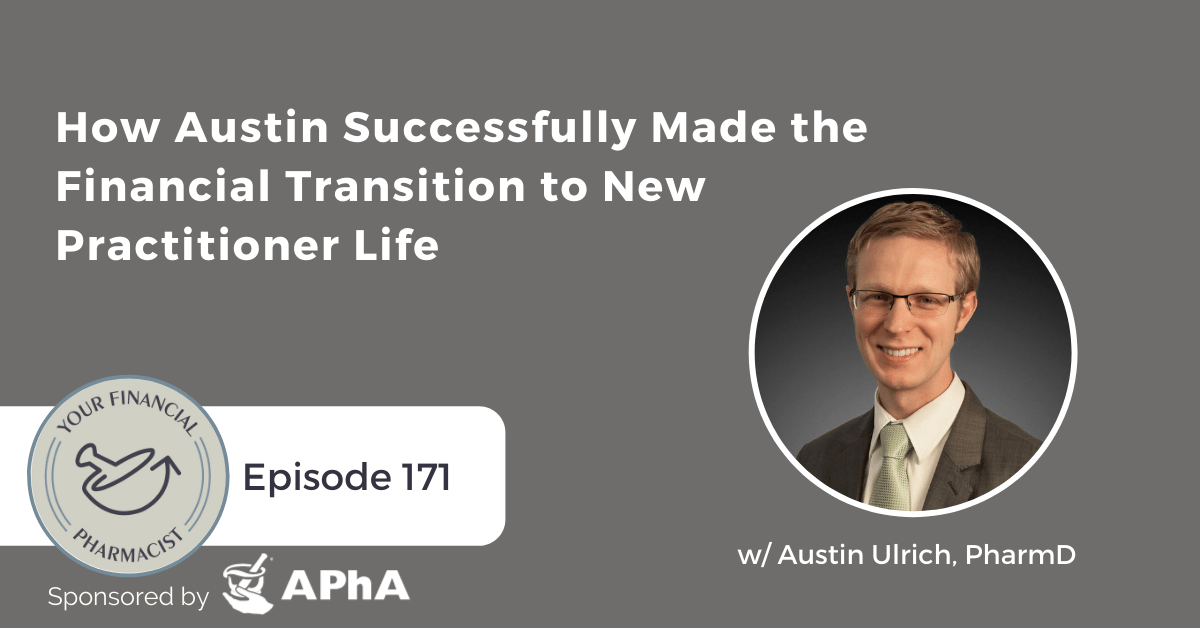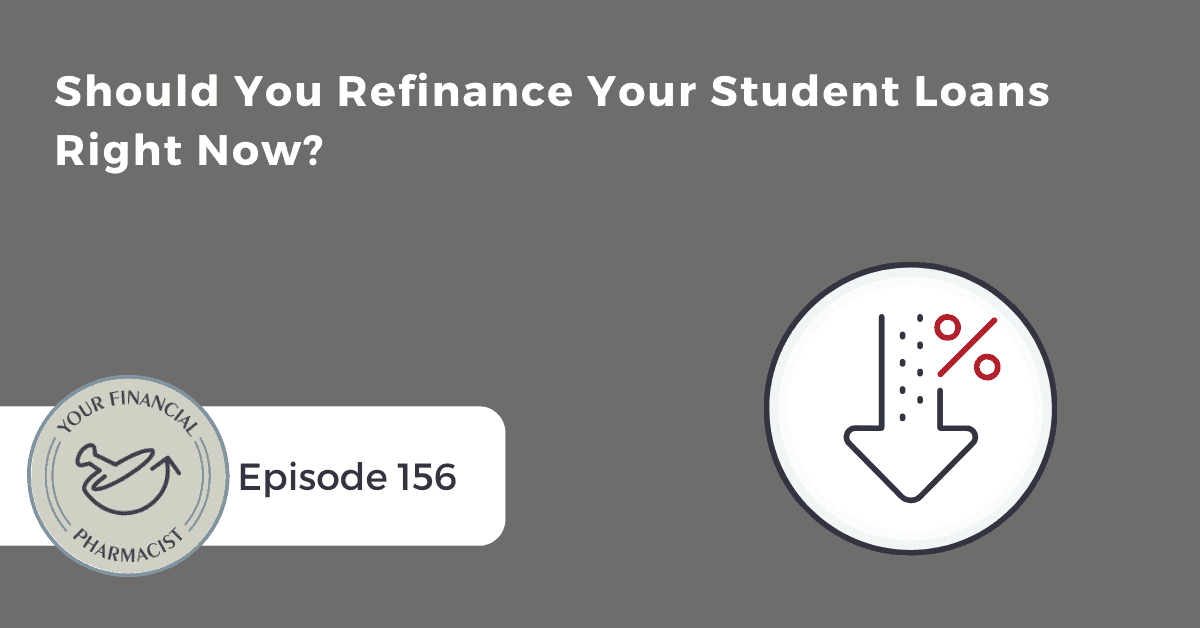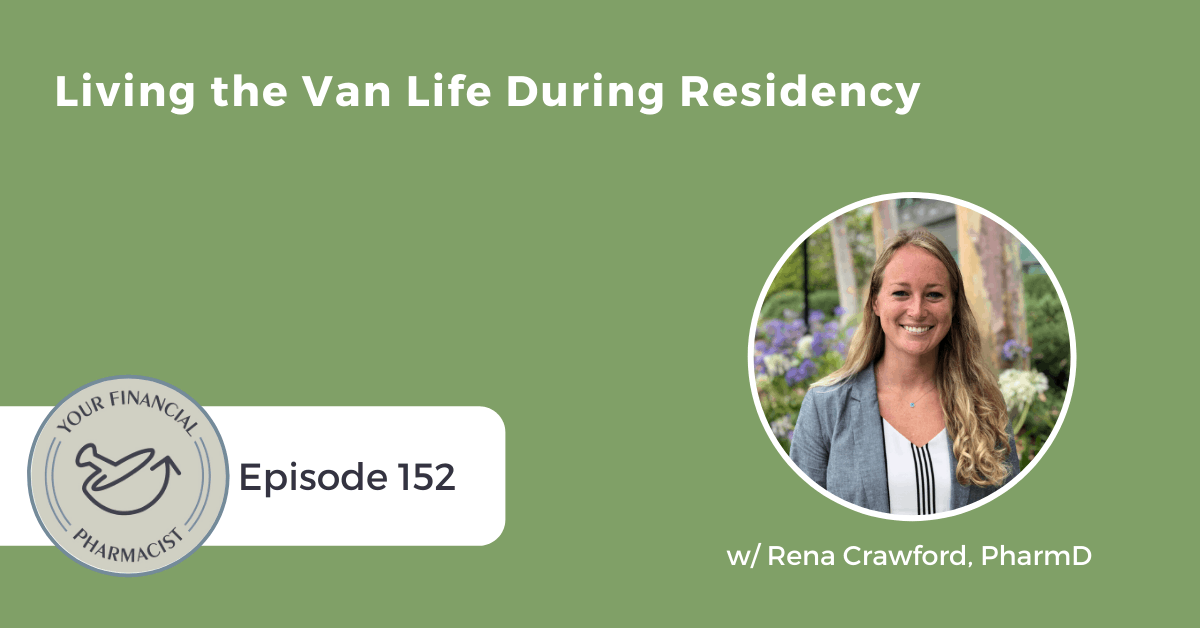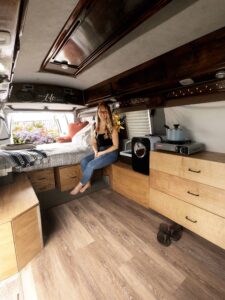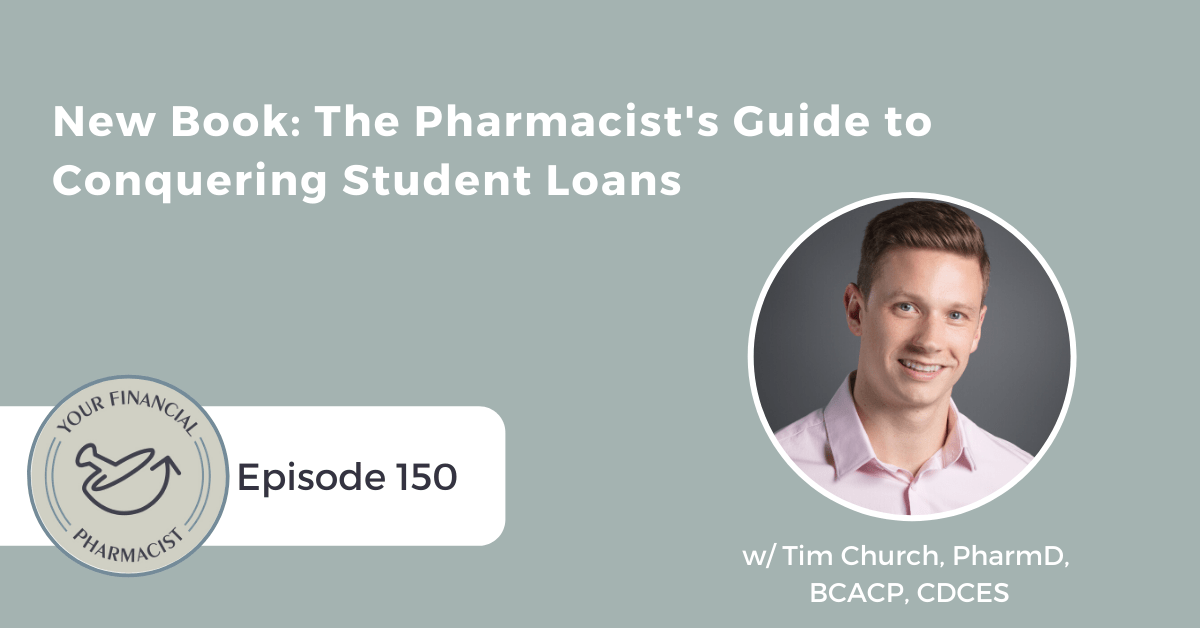How Amanda and Holden Created Freedom by Paying Off $100k of Debt
Amanda and Holden Graves join Tim Ulbrich to talk about their journey paying off $100,000 of student loans and other debt in just a few years. They share their strategies for aggressively repaying their debt, how they were able to effectively work together as a couple, and what lies ahead for them and their financial plan now that they are officially debt free.
About Today’s Guests
Holden Graves is a pharmacist working for a behavioral health hospital in Texas. He enjoys utilizing data to help problem solve and fix workflow issues. His passion is for disrupting the current healthcare model and focusing on improving patient outcomes.
Amanda Graves is a food scientist who enjoys working in the kitchen. She has a passion for cooking and loves that she can combine science and cooking to create delicious products on an enormous scale.
Amanda and Holden are excited to share their story to help motivate and inspire other professionals on their debt payoff journey.
Summary
Holden and Amanda Graves share their story of accumulating, navigating, and ultimately paying off $100,000 of student loans and car debt in a few years. Holden, a pharmacist, and his wife Amanda, a food scientist, were able to get through their undergraduate programs without acquiring any debt by working, scholarships, in-state tuition, and money from his grandfather. They took steps to minimize their debt burden when Holden went to pharmacy school by attending an in-state school and working. Holden was able to graduate with $80,000 in loans and about $20,000 in a car loan.
Holden and Amanda prioritized discussions about money as a couple before they were married and feel that it built a great foundation in their marriage. They learned a lot about each other and discovered that they had slightly different outlooks on their feelings toward their debt. Amanda was more risk averse and wanted to pay off the debt as soon as possible. On the other hand, Holden was comfortable paying it off over 5 or 10 years while focusing on increasing their investing assets. They compromised and decided to still pay off the debt aggressively over a couple of years while also putting money toward an emergency fund, house down payment, and into their retirement accounts.
To pay off the debt, they relied on automating their finances and refinancing their student loans to get a lower rate. Now that they are debt free, they feel that they have freedom and options and are going to continue saving for retirement, funding smaller goals like vacations, and focusing on increasing their invested assets.
Mentioned on the Show
- YFP Planning: Financial Planning for Pharmacists
- 2020 End of Year Financial Checklist
- The Scope of Practice: How One Pharmacist Paid Off $100,000 in Student Loans and Other Debt in Just a Few Years
- The Automatic Millionaire: A Powerful One-Step Plan to Live and Finish Rich by David Bach
- Joe Baker
- Baker’s Dirty Dozen: Principles for Financial Independence by Joe Baker, MBA
- I Will Teach You To Be Rich by Ramit Sethi
Episode Transcript
Tim Ulbrich: Amanda and Holden, welcome to the show.
Holden Graves: Thanks, Tim. Happy to be here.
Amanda Graves: Yeah, thanks for having us.
Tim Ulbrich: I recently ran across a blog post on the scope of practice titled “How One Pharmacist Paid Off $100,000 of Student Loans and Other Debt in Just a Few Years,” and after reading that article, I was inspired by your story and wanted to bring on not only Holden to share about his journey in pharmacy, school, pharmacy practice, debt accrual, which we’ll talk about here in a little bit, but also bring Amanda on the show as we know that this ultimately for the two of them was obviously a joint decision in how they were going to approach this debt and how they were going to approach the rest of the financial plan. So I really appreciate you guys coming on to share this story. Now before we jump into the specifics of your debt-free journey, how you did it, how much you had, what was the secret to success, what does this mean for you guys going forward, I’d like to start by hearing a little bit about your backgrounds and the work that you’re doing today. So Holden, let’s start with you. Tell us a little bit about your pharmacy career background, how you got into a pharmacy career, what was the interest, where you went to school and the work that you’re doing right now.
Holden Graves: Yeah, that sounds perfect. Yeah, so originally I’m from northwest Arkansas, so near where the University of Arkansas is. So what really got me interested is I actually in high school, one of my favorite teachers actually read an article to us about pharmacists and kind of the need for pharmacists as the population continues to age. So that was kind of what sparked the interest in me, and I went and shadowed — my uncle actually owns his own pharmacy, so I went and shadowed with him and just loved the rapport that he had built with his patients. They all came to him and had questions for him and trusted him just as much as their physicians. And so I just loved that rapport that he built. So that’s what got me interested. I went to the University of Arkansas for my undergraduate, where I met my lovely wife. And then went to the University of Arkansas for Medical Sciences for pharmacy school. So I did my four years there and in the middle of pharmacy school, I got married to my wife. So that was just an amazing experience from that point of view. After school, I actually applied for residency, but I didn’t match with anywhere. So that was kind of interesting, kind of left me scrambling. Luckily, I was able to find a job at the Children’s Hospital in Dallas, where I started and worked there for three years and then now currently at a behavioral hospital, still in the Dallas area.
Tim Ulbrich: Very cool. And you know, I hope here, your story there, Holden, for our listeners and if we have students that are listening, especially those that are in their fourth professional year, getting ready, end of 2020, submitting applications, getting ready for residency interviews, thinking about the matches, it’s overwhelming, right? And I think that just hearing your story about yep, the match was not successful maybe by what you had determined success would look like in that time, but I’m guessing through persistence and other opportunities and doors that opened up, you found yourself in the niche working in behavioral health. Real quick on that, like from the experience of not doing residency, how were you able to find yourself in a position like this? And ultimately, what was successful for you to be able to land a position that others may hear and say, ‘That’s a job that typically does require residency.’?
Holden Graves: Yeah, absolutely. I mean, there’s no small amount of luck that happened. I got into the Children’s Hospital. It was kind of an entry-level pharmacist position, so I was mostly in the operations side. So that part, he basically was only looking for new grads, so that worked out that I was able to get in from that avenue. And after that, I just kind of worked my way into the good graces to where I became the pharmacist in charge of one of the smaller pediatric hospitals. And so that kind of positioned me well as just having that experience of going through and dealing with the nursing leadership and the physician leadership that then ultimately allowed me to transition into the behavioral health side as well, where I’m also serving as a pharmacist in charge. So.
Tim Ulbrich: That’s great. Congratulations. I think paving that pathway is something — we need to hear more of those stories because I think we sometimes fall into the trap that if I don’t do A or B or C, it doesn’t mean I’m going to have these other opportunities. And there’s certainly many other stories out there such as yours. So Amanda, tell us a little bit about yourself.
Amanda Graves: Most definitely. So my background is actually in food science, which is awesome. So I went to the University of Arkansas, where I met my husband. And so graduated from there, and I immediately got into the food industry. And so my background’s a little bit diverse between quality assurance but majority of my career has been in research and development. And then I also dabbled in sales in the food industry for awhile, kind of on a technical sales side. But currently, I work in the culinary department for a restaurant company. So I get to manage kind of the food and culinary side from a science perspective, which is really great for me to be able to combine — I love food, and I love to eat, so I get to combine the culinary arts with the food science side and just make things come to life on a mass scale.
Tim Ulbrich: What a unique career path. When I read some of your background of combining science and cooking, I was like, heck yeah! I mean, that’s awesome. I think one of the reasons I enjoy cooking so much is just, you know, that bringing in some of the science and understanding it. It reminds me of some of the pharmacy training. I think there is so much both art and science in cooking. So how did you find yourself in that career path and even having an interest in that area?
Amanda Graves: It really worked out well. So my high school had a culinary arts magnet program.
Tim Ulbrich: Cool.
Amanda Graves: So I did culinary training for the first three years of high school and then senior year, I was an intern in a hotel kitchen, which was an absolutely incredible experience. But with that, I also learned I didn’t want to be a chef. And just through seeing that, I was like, but I still love food and also in my high school, I was in the science magnet program, and I took chemistry for two years because I just love chemistry. And so just kind of thinking about how I can combine my love of science and food, I just kind of stumbled upon food science, and it really just is the perfect combination.
Tim Ulbrich: I love it. And before we go on to talk more about your financial journey and your story, which I’m confident is going to motivate, inspire other pharmacy professionals and others listening on their own journey and their own debt payoff, what they’re working through as well, I have to know. I don’t hear the thick Arkansas accent that I have heard from other guests on the show that have graduated from UAMS or Harding. What’s the deal? Are there like levels of Arkansas accent?
Holden Graves: Yeah, there’s — up in the northwest corner of the state where the University of Arkansas, we kind of more have the less southern and then as you get closer into Little Rock and the southern part of the state, it gets a lot thicker. Amanda’s also actually from Dallas too, so she doesn’t have that from Arkansas.
Tim Ulbrich: OK. That explains it.
Amanda Graves: So I definitely don’t have a southern accent. And on Holden, it only comes out on certain words occasionally but otherwise not too much.
Tim Ulbrich: Yeah, I’m thinking of other guests we’ve had on the show that are doing some awesome things, debt repayment, real estate investing, others in the Arkansas area, and it was definitely a thicker accent.
Holden Graves: Yeah, that’s more the southern part of the state.
Tim Ulbrich: Absolutely. Well, let’s jump in. Paying off $100,000, student loans and other debt in just a few years, and so we’re going to talk about how you did that, how you accrued it, how you paid it off, why you did it, what was the strategy. So Holden, kick us off here. Was this a majority or all of your student loan debt? Tell us about the amount and also the position and how you got into that.
Holden Graves: Yeah, absolutely. So I guess it depends on who you’re talking to on whose debt it is. So according to me, it’s all of my student loan debt. According to my lovely wife, it’s all of our student loan debt. So it was mainly my schooling that accounted for all of that. So as far as the actual student loan debt goes, we were about $80,000 in student loan debt. But in the middle of pharmacy school and then right after pharmacy school, we actually purchase two new cars. And so at the lowest point, we had about $100,000 in total debt.
Tim Ulbrich: OK. So about $80,000 in student loans, about $20,000 in two cars. That brings us together to that $100,000. Now, I’m sure many of our listeners hear $80,000 and say, “I wish I only had $80,000 in student loan debt,” which you know, it’s unfortunate that I even have to say that out loud, but that’s the reality, right? So we have Class of 2020, we now have the median student loan debt that is north of $175,000. I’ve often talked and worked with pharmacists that exceed that or perhaps even couples that have more on top of that, so $80,000 — I don’t want to mitigate what you guys have done. I mean, it’s incredible. But my question there is what was the strategy? How were you able to keep the debt load I guess “low” of $80,000 compared to what we see out there as the normal?
Holden Graves: Yeah, absolutely. Yeah, so we were very intentional — or I was very intentional early on whenever we were accumulating the debt. So luckily, we were both able to graduate undergrad with no debt, so it was just pharmacy school that I needed to finance my way through. But I just still wanted to take out the minimum that I possibly could. So I really only took out enough loans just to cover tuition. I never took out anything extra to cover expenses or rent or anything. I had a little bit saved up because I actually worked in a pharmacy in undergrad and saved up some money there. And then while I was in pharmacy school, I did still work as well. So I still was — that was basically able to cover my rent and food payments were basically coming from what I was able to work. So that’s kind of the way we did that. And then just going to our in-state school, University of Arkansas, is one of the lower cost programs, so just trying to stay as low cost as we possibly could with that was a big key.
Tim Ulbrich: Yeah, multi-prong approach, I think that’s a good strategy. A little bit of strategy in where you go to school, in-state tuition, as well as being able to work and some other things that can help reduce. And as our listeners know very well, whether they are in the debt accrual or debt paydown phase, anything you can do to reduce that indebtedness while you’re in school is going to pay dividends obviously from what you don’t have to pay back into the future. So in the article that you wrote and I referenced earlier in the show, you mention that while you were still in pharmacy school and before you were married, you had discussions about money, which I think and I’ve talked about on the show before is so important for every couple to be doing as early as you can, having some of these big discussions around money, here, we’re obviously talking about debt but of course it’s much bigger than that. So Amanda, tell our listeners about those conversations, you know, how they went, how you felt about the debt even though it wasn’t your own debt but was going to become your collective debt, how those conversations went, and what you ultimately discovered about each other through those conversations.
Amanda Graves: Yeah, most definitely. So we both knew that a great foundation in marriage is communication, and we also knew that financial stress can one of the major stressors in a marital relationship. So we wanted to start those conversations really early on, just to make sure we were on the same page and kind of had a strategy. And then for my personal perspective of coming in, you know, I was all-in, I was very supportive of Holden and going to pharmacy school and that included the student loan debt that came along with it. So I — as Holden mentioned earlier, I very much saw it as our debt, not just his debt. And so together, we needed to kind of make that plan to address it. But like you mentioned, a lot of those early conversations, we got to learn a lot about each other and just how we viewed money and kind of those different backgrounds that we had from a financial perspective and kind of blend those together to make a plan so we had that even before we were married, which helped just to kind of continue to address that as we were kind of going through the process.
Tim Ulbrich: That’s great. I think conversations are important, as awkward as they may be at first or however you break the ice, you know, I think the outcome is incredibly valuable, not only on the debt repayment part, but of course as you guys know, from living this, this is just one part of the financial plan, so having open communication here hopefully will translate to other areas as well. Holden, for our listeners that perhaps find themselves in a situation where they’re carrying a big debt load, maybe a serious relationship, haven’t yet had that conversation, maybe they’re feeling a little bit of guilt about hey, I’m bringing this debt into the relationship, I’m not sure how someone’s going to perceive this, any words of wisdom or advice that you would give them here in how you were able to approach this subject? Or was it just a natural conversation that really came to be between you and Amanda?
Holden Graves: I think the — just the foundation of our relationship and just the trust that we were able to give to each other that she was open to hearing exactly what it was. And the main thing is that I didn’t want this to be like me v. her or anything like that. Like I wanted us to come together to try and tackle the debt together and try and do everything. So I didn’t want to take her feelings out of the situation, and I wanted to take her advice as well because she’s much smarter than I am. So I definitely, I wanted to bring us both on the same page because it’s a lot easier if we’re both know what we’re heading towards as opposed to two people at odds with each other.
Tim Ulbrich: Absolutely. And that is a good segue into one of the questions I like to ask individuals such as for you guys as you’re going through this journey together and have chosen an aggressive debt payoff strategy is what’s the purpose? What’s the reason? What’s the why behind this aggressive debt repayment? And we’ll talk in a moment about exactly how you did it, but I think that question is one that I talk often on the show about it’s so important to answer that. And I don’t necessarily believe there’s one right answer, but we know there’s options, right? So you guys could have taken out this $80,000 in student loan debt, you could have taken out 20+ years or you could have aggressively paid it off like you did, whether that’s in the federal system or with a private lender. So tell our listeners — and Amanda, I want to start with you, and Holden, feel free to add on from there. Tell our listeners about what was the purpose. What was the why behind this aggressive debt repayment strategy?
Amanda Graves: So for me personally, which in my answer might vary a little from Holden’s, but for me, the why was just the stress of just having that debt kind of hanging over us, I am personally very risk-averse. And I just try and avoid anything that would either be risky or cause me more stress. Really, it was just the fear of it just kind of looming over everywhere. And I just wanted it to be gone. I just wanted it to be completely gone as fast as possible. And I was ready to do kind of whatever we needed to do to get there to kind of move on to what life would look like after the debt was paid off and just be able to have not that standing payment of the loan every month but being able to kind of free that up to have a little more flexibility in the future.
Tim Ulbrich: Holden, what about you?
Holden Graves: Yeah, mine was kind of along the same viewpoints of it’s just the stress of it hanging over you. Less so of the stress that it was hanging over me and more so of what it was hanging over Amanda. So I just could see the way that she just kind of just did not like the stress and I just knew that that’s just something we needed to get out of our lives as soon as possible. I was kind of more on the train of, you know, kind of doing the five- or 10-year repayment and just kind of letting it drag out and be invested. So kind of my viewpoint was let’s work on getting our invested assets up as high as we can as early as we can. So that’s kind of where the compromise came in. If it was up to Amanda, we probably would have had it paid off in that first year. So we kind of settled somewhere in between so that way we could make sure that we were maxing out some of our investment accounts, going about it that way as well.
Tim Ulbrich: Yeah, and I think compromise is such an important summary of what you just said. You know, I think some of our listeners may hear $80,000 and their natural tendency may be hey, I’m going to take that out, low interest rate, as much as I can take it out long. Again, there’s not a wrong answer, depending on somebody’s interests and how they feel about the debt. And I always say it’s the numbers plus the emotions. And both of those are really important, right? So I like what you said, Holden, you know, you may have leaned toward one strategy, but when it’s causing stress or anxiety, I think this is an area — and I say this with emergency fund as well — there’s places to defer, and there’s places where you maybe push someone to come more to the middle or maybe an area that they’re not as comfortable with. And I think this is one when you’re talking about the stress and when you’re talking about some of those other emotions that can come with this debt load, probably not the area to be pushing somebody, even if mathematically you could make an argument that hey, if I put more in investing, it may mean more in the end. So kudos to you guys for working through that.
Holden Graves: Yeah, and don’t think I didn’t also try that approach too. But it did not completely get rid of the stress from her point of view.
Tim Ulbrich: I can see the conversation of like, hey, here’s the compound interest calculator, and look at the numbers, and what if we did this? What if we did that?
Holden Graves: That’s exactly what I tried to do.
Amanda Graves: Yes, we did go over that.
Tim Ulbrich: So I want to build on something, Holden, that you said. You know, I heard you say investing was a priority. Many of our listeners are often trying to balance student loans, investing, emergency funds, paying off a car debt such as what you mentioned, saving for a home, starting a young family, making sure they have the right insurance policies in place, the list goes on and on. And I think that can be very overwhelming for folks. And there’s kind of different strategies of sometimes you balance a lot of these, sometimes you focus in on one, depending on the goal, depending on the timeline, again, depending on the math, how somebody feels. So talk us through your strategy in terms of how you approached the debt alongside of investing, alongside of emergency funds, and I know you guys currently have a home, so also being able to save up for the down payment on a home. How did you bring those issues to the table and then determine how you were going to allocate funds into what priority?
Holden Graves: Yeah, so basically we just kind of came and sat down to be able to discuss what our goals are. We actually do a monthly check-in, meeting, just a financial checkup every month so that way we can make sure we can see what we’re — we track all our spending, so we see what we spent on, how much we’ve got left over for the month and if there’s anything we need to adjust for the next month and the next year and then just also be able to talk about our goals and what goals we have. So it was kind of just that approach of just getting to the table and seeing everything. So of course mostly from Amanda’s side, it was we need to pay off the car loan, we need to pay off the student loans, and she was also a little bit like a down payment for a house because we also wanted to get into a house. And then big into the emergency fund as well, so that was kind of the other part. And so then of course I agreed with all of that. Also saving just as much as we could in our retirement accounts, so we started off just a little bit over the match and then just kind of slowly racked up over a year or two to be able to max out our 401k’s.
Tim Ulbrich: And I’m guessing our listeners may be thinking what I’m thinking, which is, you know, you’re making it sound very easy. But even when you look at that number, I mean, $80,000 or $100,000 and some over three years, people will do the math, $100,000, 36 months, those are big monthly payments. And so it wasn’t just the student loan debt or the car debt. It was also the down payment that you were saving for a home, it was also investing for retirement, all of those things need cash, right? And at some point, you’ve got to figure out how we can lives off of less than we make so we can free up cash to be able to achieve those goals. So tell us more, Amanda, like what was the strategy or what was the success, the secret sauce, whatever you want to call it, for you guys in terms of being able to keep expenses down so you could ultimately free up cash and put that cash towards the goals. What were some of the sacrifices or cuts that you guys had to make?
Amanda Graves: One thing I think that we learned — and I think Holden mentioned it earlier — that we got married in the middle of pharmacy school, so for those first two years of marriage, Holden was in school and I was working. So we kind of had figured out how to live off of one salary. And then even though we were super excited, you know, come graduation and Holden getting a job, we really tried to live within the same means that we had been for those previous two years and then just kind of bringing the new paycheck that we were getting to go towards all those different things of meeting our financial goals. So I think that was the big thing was still living off the same budget and then just freeing up the rest to our financial goals.
Tim Ulbrich: And how did automation, Holden, if at all, play a role here? You know, we talk a lot about on the show, once you’ve got a plan, really one of the best things we do is get out of our own way to make sure the plan actually happens. And automation is often the vehicle, the system, that will allow that to happen. Did you implement kind of automatic withdrawals towards these payments? Or how did you make sure your goals were being achieved while you had other competing priorities for your expenses?
Holden Graves: So of course, I went to the University of Arkansas, so Joe Baker is —
Tim Ulbrich: Yes.
Holden Graves: Was there, and he was —
Tim Ulbrich: Shoutout to Joe.
Holden Graves: He was my professor. Yeah. I know, I still need to get his book, so don’t tell him I haven’t gotten it yet. He really kind of set us up, so that was a really good foundation. And then at the time, he was recommending “Automatic Millionaire,” so it was before y’all had come out with your book. And so that was a big one that I just read that and just like loved this of these people that just kind of never really made that much, and they just saved automatically and paid off stuff and all of a sudden, they had three homes and like $1 million in the bank just because they were automating everything and not thinking about it. So that was a big thing for us. So everything we had was automated. We had our 401k’s automated, we had basically everything coming out of my paycheck, so my paycheck would get deposited every other Thursday. And Friday, we had all of the automatic drafts going towards our different savings accounts and also towards our loan accounts as well.
Tim Ulbrich: Awesome. And we’ll link in the show notes “The Automatic Millionaire” by David Bach. We’ve talked about that on the show before. Also to Joe Bake himself, “Baker’s Dirty Dozen: Principles for financial independence,” excited about that new resource coming out. And I also would add, to our listeners that want to learn more about this concept of automation, one of my favorite books — you’ve probably heard me talk about it before — “I Will Teach You to Be Rich” by Ramit Sethi. He does an awesome job of actually getting in the weeds on kind of what could this look like from a system standpoint and how can you implement it? And I think for many people, the idea of it seems more complicated than the actual implementation process. So I’d recommend those resources. Before I ask you guys about hey, what’s ahead now that we’ve got this debt paid off, we’re in the home, I wanted to, Holden, for a moment go back to the student loans. I didn’t ask you what the strategy was there. Was it staying in the federal system, pay them off? Was it refinance the loans? And any advice you would have for our listeners who are trying to make that distinction or that decision.
Holden Graves: Yeah, absolutely. So we went with the route of refinancing. So I never really thought about getting it to filing or attack this separately or going into the weeds on that. I just looked at what our tax return was and tried to plug that into the REPAYE and PAYE options and just realized that we’d actually be paying more towards the debt doing that than just the standard 10-year payments. So that was never really an option was doing that. And then I didn’t really want to be tied down with one particular company or one particular field, so I didn’t want to be in the Public Service field of five years in, I’ve realized, wow, I don’t really like this, I didn’t want to be stuck in that type of situation. So since we were going to be so aggressive with it, we decided to refinance and got a much lower rate on the refinance. So just kind of went at it that way and paid it off just as much as we could, as quickly as we could.
Tim Ulbrich: That makes sense. And so you know, as we now look at the future and what’s ahead, we’ve got an emergency fund in place, we’ve got student loans paid off, check, we’ve got the cars paid off, check. Obviously you’re in the home, so the down payment happened, check. And you were investing for retirement along the way. So I’d like to hear from both of you, both some of the numeric goals of what’s ahead, where do you guys want to focus on in terms of the x’s and o’s in your financial plan and then perhaps some more of the softer sides of the financial plan, you know, what are you hoping this means for your family going forward? So Amanda, you want to kick us off?
Amanda Graves: Yeah. So now that we’re kind of moving forward as we’ve checked all those boxes, I’ll let Holden speak to more of the financial strategy because he’s better with that. But —
Tim Ulbrich: He’s the nerd. He’s the nerd, right? Let’s be honest.
Holden Graves: That’s it.
Amanda Graves: Oh, he totally is. He totally geeks out on finances, which I love. And he does really great at kind of the future planning where I’m more of the close-in, monitoring the monthly budget. So I’m kind of the —
Tim Ulbrich: Sure.
Amanda Graves: The monthly person whereas he kind of does everything else. But it’s just been really great to kind of be a partner and seeing those different strategies kind of come to life. And what that means too is it kind of gives us the freedom to do what we want both now and in the future, you know, with saving for our retirement but also we have smaller goals too. We have automatic savings for vacations. So if we decide we want to take a family vacation, it won’t be a big financial stress because we created that savings just so that way, we can do little trips or activities and different things like that.
Tim Ulbrich: And Holden, give us the, you know, what’s the next 3-5 years look like? What’s success look like for you guys going forward now that you’re past this $100,000 of debt?
Holden Graves: Yeah, absolutely. Yeah, so we’re just kind of focused right now on just kind of accumulating as much as we can. It’s just kind of where like we don’t have specific 3-year to 5-year goals. We usually go one year at a time. But for the most part, it’s just 3-5 years, we’re still going to get 3-5 years of invested assets to be able to cover us for if anything were to happen or if anything — if one of us needed to take a break or walk away from a job that’s stressful. So that’s kind of the biggest things there. One thing Amanda didn’t mention, though, was actually when we paid off our student loans. We actually paid off our student loans in October of 2019. And our son was born at the end of November that year. So about a month difference, so it actually was — it worked out perfectly because it was just amazing because we really didn’t feel any richer after we paid off the loans because immediately Amanda went on maternity leave. But it really gave her the freedom to take the full 12 weeks off and make sure that she could go back.
Tim Ulbrich: Sure.
Holden Graves: Now especially, she could decide later on whether she wants to take a smaller role with what she’s doing or just step away altogether. It just kind of gives us the freedom to have those options. So we’re just trying to build up that so that it takes a little bit of the stress off Amanda too so she’s less worried about if she wants to step away or just slow down a little bit with work.
Tim Ulbrich: Freedom and options. Couldn’t have said it better. I think, you know, for you guys, this certainly is the case. You’re moving into what I would say is the offensive part of the financial plan and really being able to build some of the wealth into the future, obviously achieve other goals that you want to achieve and have the freedom and option if for whatever reason, you didn’t want to work or work part-time or to be able to replace some of what would come from a traditional W2 income. So congratulations on the progress of what you guys have made. I’m excited for what lies ahead for you guys as well. And I really appreciate you taking the time to come on the show to share your journey.
Holden Graves: Yeah, thanks for having us on, Tim. It was a pleasure.
Amanda Graves: Thank you so much.
Current Student Loan Refinance Offers
[wptb id="15454" not found ]Recent Posts
[pt_view id=”f651872qnv”]


